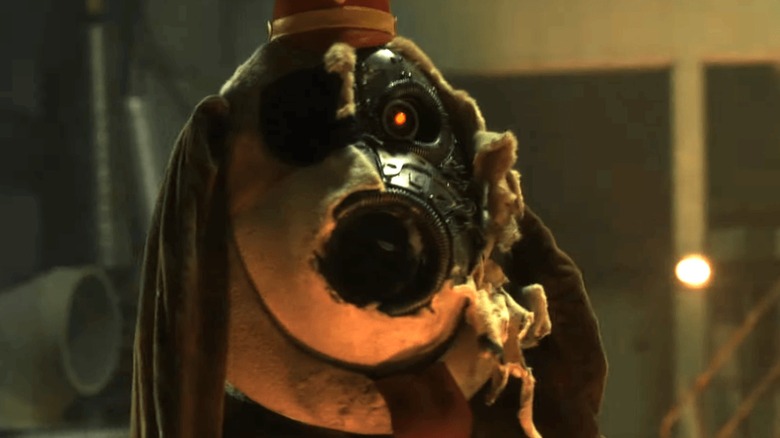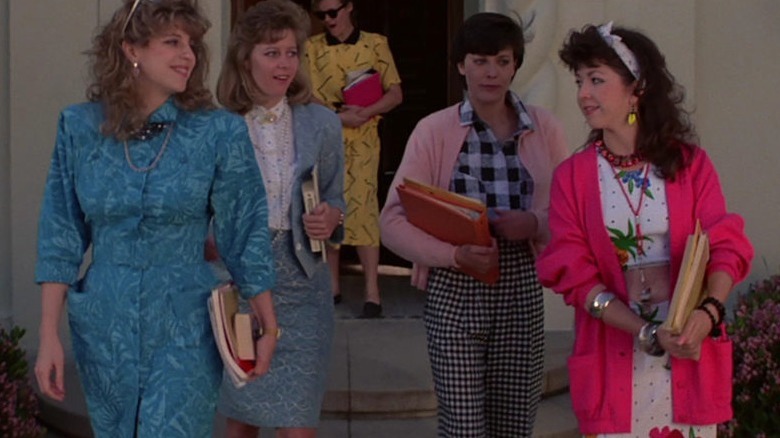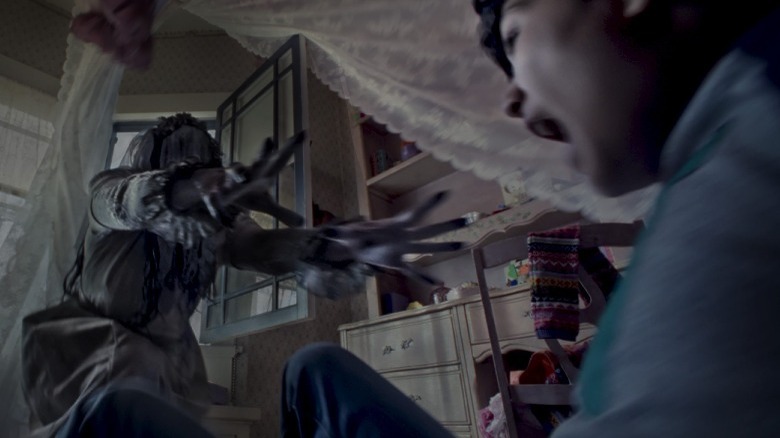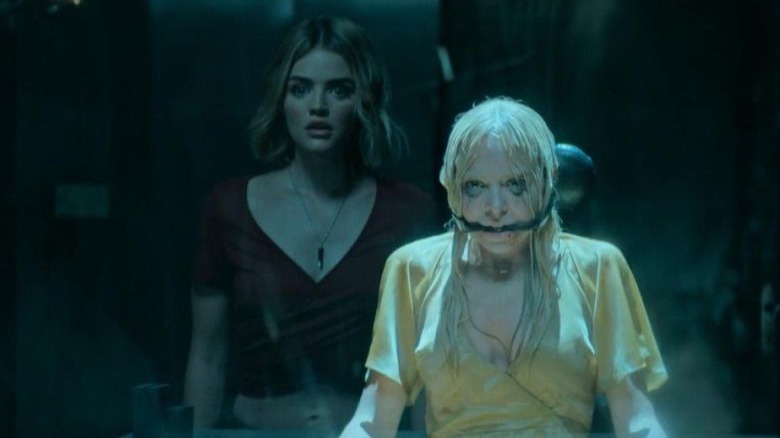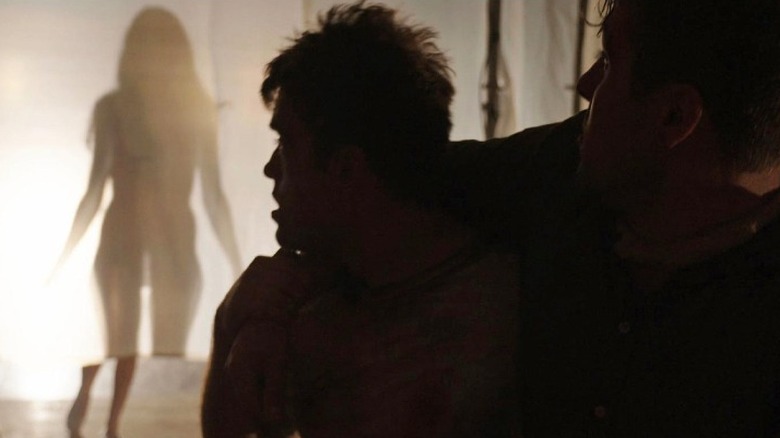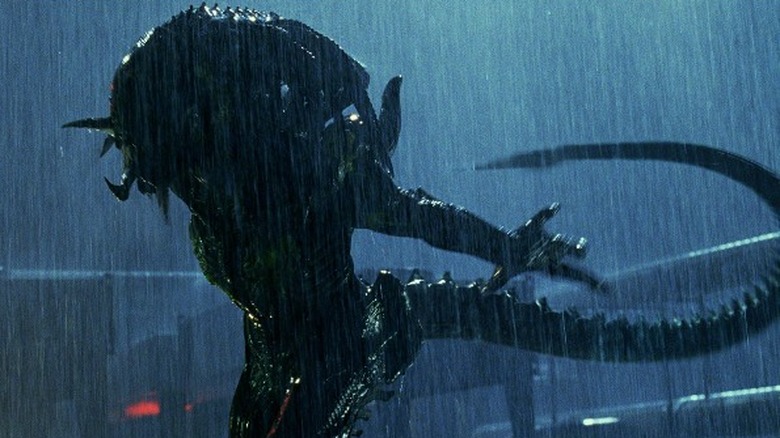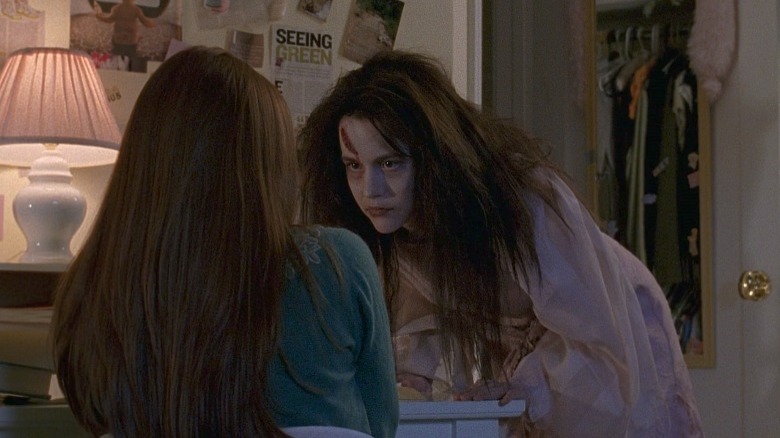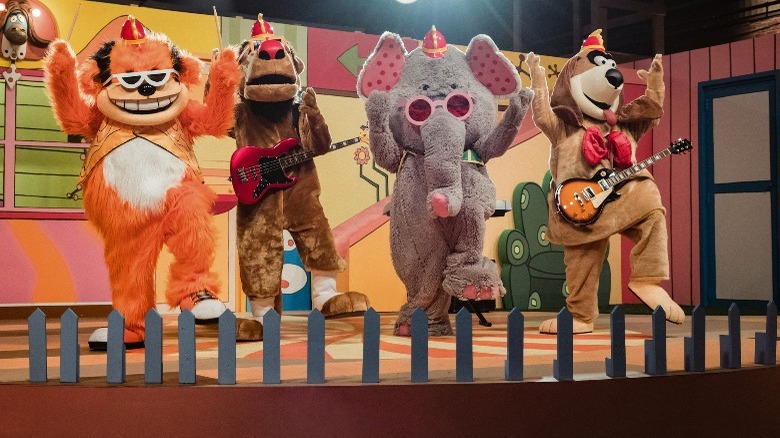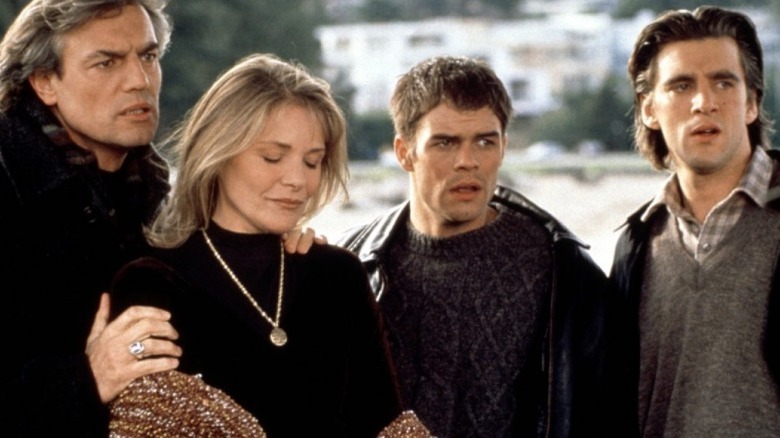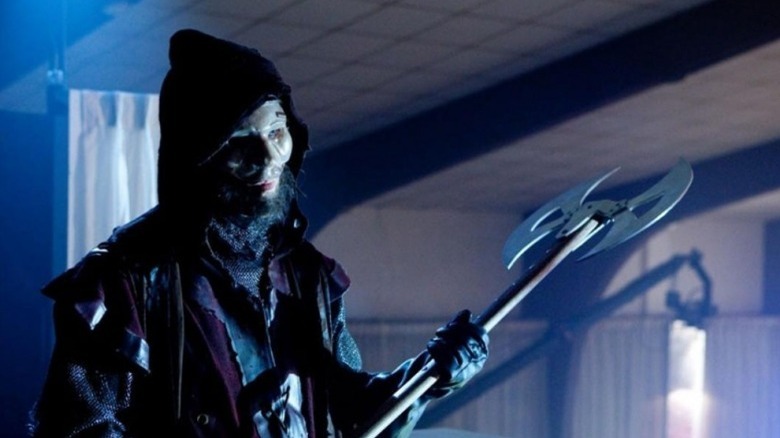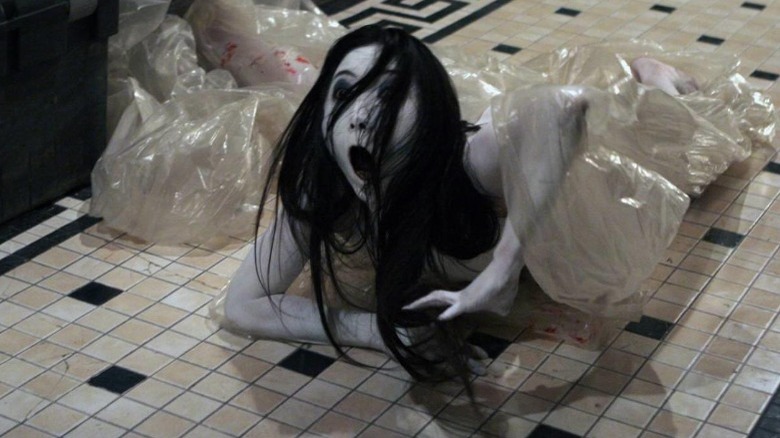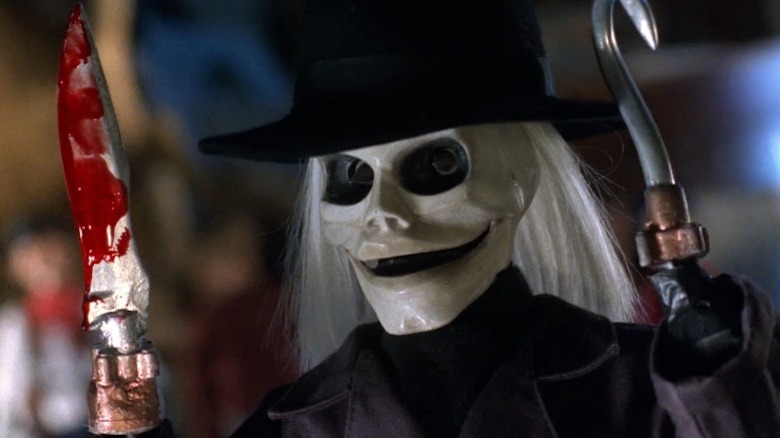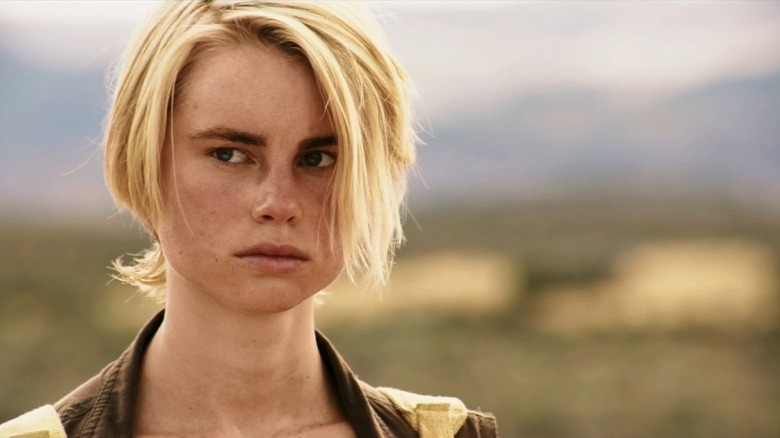Horror Movie Spinoffs You Didn't Know Existed
The horror movie universe is vast. Beyond franchise stalwarts like Freddy Krueger and Michael Myers, there is a vast landscape of genre properties that continue to stretch the boundaries of what a horror movie can and should be. Some are beautiful, some disturbing, and most curiously, some are bonafide spinoffs — horror movies with the innate swagger of a pre-established property. Like a frightening rendition of the Marvel Cinematic Universe, horror itself operates within a big, bloody realm of crossover, dovetailing potential. "Annabelle" was born from "The Conjuring" franchise, and Jason Voorhees and Freddy Krueger squared off in an ambitious slasher death match.
Here, we'll be taking a look at 13 horror movie spinoffs you probably didn't know existed. These are affiliated with their source material, but they're not quite sequels and not quite remakes either. Some added horror elements to non-horror properties, while others recognized the potential of their cinematic universes to expand the scope of their progenitor's terrors.
Sorority House Massacre
With the release of Syfy's "Slumber Party Massacre" remake, a new generation has been introduced to the bloody, comic wonders of Amy Holden Jones' slasher masterpiece. However, general audiences might not realize that the original 1982 "Slumber Party Massacre" is the first in a long-running series of mostly female-helmed slasher movies. Aside from the original, the most famous might be "Sorority House Massacre," the second trilogy under the "Massacre" moniker.
Replete with the same black comedy and gruesome kills, Carol Frank's "Sorority House Massacre" is pretty much "Slumber Party Massacre" in a sorority house. Curiously, the "Massacre" timeline is confoundingly complicated with its sequel, "Sorority House Massacre II," which borrows footage from the first "Slumber Party Massacre," recontextualizing its killer and creating a new story from old footage. "Slumber Party's" killer is renamed, his backstory altered, and the temporal consistency of the "Massacre" movies is slaughtered alongside it. There's a charm to every movie in the franchise, however, and "Sorority House Massacre" is just as fun and ridiculous as the movie that inspired it.
The Curse of La Llorona
Audiences should be forgiven for thinking Michael Chaves' "The Curse of La Llorona" is part of the "Conjuring" cinematic universe in the same way both "Annabelle" and "The Nun" are. After all, Chaves would go on to helm the third entry in the "Conjuring" trilogy, rendering "La Llorona" a trial run for his big showcase there. However, that isn't the case, with the directors repeatedly remarking in interviews that "The Curse of La Llorona" isn't a "Conjuring" movie at all.
The answer for that is pretty simple. Speaking with Dread Central, Chaves stated that "The Conjuring" movie producers were mostly absent from "The Curse of La Llorona," and consequently, it can't be considered canon with the rest of the franchise, despite a handful of playful easter eggs. He additionally notes that La Llorona, an entity well known in Mexican folklore, doesn't quite mesh with the fictional entities of the other "Conjuring" films. In other words, she's historic enough to stand on her own. It certainly seems like an entry in the franchise, though. With Chaves' demonstrative rebuttal, it's arguably the first and only indirect spin-off the franchise has seen.
Fantasy Island
The plane! the plane! "Fantasy Island" arrived as a dud. With a remarkably low score on Rotten Tomatoes, Herve Villechaize's classic greeting signaled the arrival of one of the genre's strangest adaptations in recent memory. Younger audiences, the core demographic targeted with Blumhouse's PG-13 spinoff, likely didn't even know "Fantasy Island" was adapted from Gene Levitt's ABC series that ran from 1977 to 1984. While the show was reasonably popular, it doesn't necessarily command the same contemporary familiarity as others of its ilk.
Curiously, "Fantasy Island" wasn't even a horror show. Sure, the creators dabbled with some spooks from time to time, but writ large, "Fantasy Island" was principally a fantasy-tinged morality play. Guests would arrive, live out their fantasies, and leave with broad stroke lessons on life and love. Shifting the dial toward horror doesn't exactly work, and "Fantasy Island" the movie piles on twist after twist until the entire enterprise collapses under its ambitious weight. Still, it's one of Hollywood's most interesting spinoffs to date, and there's no denying that remaking classic shows as horror movies isn't a terrible idea. An "I Love Lucy" slasher? "All in the Family" with cannibals? On "Fantasy Island," the possibilities are limitless.
Siren
The "V/H/S" series is the found footage anthology that could. Anthologies are always at a distinct disadvantage, regardless of genre (though horror anthologies are by far the most popular). By combining so many disparate styles and stories, there are always going to be weaker entries on account of the unique opportunity to directly compare one short to another. While not every "V/H/S" entry across the franchise is great, they're remarkably strong —"V/H/S: Viral" notwithstanding — and the first entry might be the best of the bunch.
The first segment is David Bruckner's "Amateur Night," a short about some guys looking to crack the amateur porn market and their encounter with a succubus, was successful enough to launch a spinoff of its own titled "Siren." Bruckner returned to produce, handing over the directorial reins to Gregg Bishop, a name horror fans might recognize from the cult-favorite "Dance of the Dead." Expanding the scope of the original short, a bachelor party goes awry when the fabled succubus is released and starts mowing everyone down. While it isn't quite as successful as the short, it's an inspired horror outing, making the case that more anthology shorts might benefit from the feature treatment.
Alien vs. Predator: Requiem
Domestic audiences didn't see the Brothers Strause's "Alien vs. Predator: Requiem." Sure, 67 percent of its total box office intake came from international ticket sales, but that statement is meant to be taken literally. They did not see it. Notorious for its abhorrently poor lighting, "Requiem" is currently sitting at an abysmal 12 percent on Rotten Tomatoes. It's a sequel that everyone wanted but no one saw.
Picking up after the events of Paul W.S. Anderson's "Alien vs. Predator," there was considerable promise at the start. "Requiem" returned to an R rating. The first was controversially rated PG-13, despite both titular namesake franchises and their legacies of violence and body horror, so an R rating was a good augur. The inclusion of the "Predalien," an alien and predator hybrid first introduced at the end of the last movie, also yielded hope. Too bad the movie was impossibly dark, nauseatingly edited, and frankly, pretty boring. It's not a total bust. There's an innate sense of wonder watching aliens descend on suburbia, but "Alien vs. Predator: Requiem" falls so far short of its promise that it's no wonder general audiences might not even know it exists.
Urban Legends: Bloody Mary
The horror films of the early aughts might have thought they were breaking new ground, but in truth, they were following the slasher rhythms the 1980s were known for. With the release of Wes Craven's "A Nightmare on Elm Street" in 1984, seminal slasher franchises shifted course, adding ill-advised supernatural angles to their plots to emulate Craven's unprecedented success. "Hello Mary Lou: Prom Night II" and "Friday the 13th Part VII: The New Blood" were among those that inexplicably went supernatural with their once human killers.
"Urban Legends: Bloody Mary," a spinoff of the "Urban Legend" slasher series, follows the same template as a direct-to-video entry in name only. After a high school prank goes awry, a curse is born. Decades later, the prank is repeated, and the titular Bloody Mary returns to enact her revenge. A bunch of high school bullies is killed in increasingly gruesome ways, all of which parallel urban legends. There are spider bites on the cheek, haywire vending machines, and electrocution by way of urination. It's funny in a gruesome B-movie way. While it bears little resemblance to the "Urban Legend" duology, it's a fun supernatural reinterpretation of old material.
The Banana Splits Movie
"The Banana Splits Movie" is what "Fantasy Island" should have been. A horror spinoff of a classic show, "The Banana Splits Movie" takes it one step further by reimagining a children's show as a bloody, "Five Nights at Freddy"-style slasher. "The Banana Splits" was a children's variety show that first aired in 1968. A Hanna-Barbera production, it featured four animal mascots, the titular Banana Splits and their fictional rock band.
"The Banana Splits Movie," on the other hand, feels culled straight from a creepypasta. In Danishka Esterhazy's spinoff, the show has been revived, and a young couple brings their son to a live taping, hoping to lift his spirits. When the software in the animatronics malfunction, the Banana Splits go haywire and start murdering everyone on the lot — audience and executives alike. It's deliberately tongue-in-cheek, though there is something innately terrifying about homicidal animatronics, harkening back to the scariest parts of childhood Chuck E. Cheese trips and the horrifying thought that the animal band might just be alive. "The Banana Splits Movie" is worth a look, especially as a gag for older audiences who remember the innocent variety show. They're in for a "Banana Splits" trip.
Poltergeist: The Legacy
Even diehard fans of the "Poltergeist" franchise (the first two, anyway) might not know that the series got a spinoff television series that aired on Showtime from 1996 through 1999. It's fair, especially in the early days of cable television where not every household was subscribed to Showtime, but for horror buffs interested in fleshing out their credentials, it makes for an interesting time capsule of spinoff potential.
Fan-favorite Freelings are nowhere to be seen, however, as the series originates from a one-off plot beat from the first. The Legacy, a secret society that battles the occult, assists in saving Carol Ann in the first film, and the spinoff series tracks their exploits with no connection to the movies that came before. Following the monster-of-the-week template, each episode offers up a healthy dollop of occult scares, mysterious beings, and haunted abodes. The cast is uniformly strong, and for the most part, overarching narrative threads command interest. While it enjoyed moderate success at the time, it never quite became a hit, but that shouldn't scare interested parties from checking out what this legacy has to offer.
My Super Psycho Sweet 16
Everyone watched MTV's "My Super Sweet 16," and if someone says they didn't, they're probably lying. An early aughts masterpiece of conspicuous consumption and exploitative antics, the series followed a new guest every week and the lavish, over-the-top sweet 16 (or quinceañera) the respective participants were throwing. A progenitor of the current trend of bridezilla shows, the teens in question were often cruel, manipulative, and inordinately entitled, making for a show audiences loved to hate.
The show was so successful, so zeitgeist-defining, it launched several spinoffs, the most interesting of which is the made-for-tv-movie "My Super Psycho Sweet 16." A spoiled girl hosts a lavish party, and as expected per the title, a killer bucks convention and shows up uninvited, slaughtering hapless teen after hapless teen. While never exactly scary or violent, it was an accessible slasher gateway for young audiences and successful enough to warrant two sequels.
Sadako vs. Kayako
Kōji Shiraishi's "Sadako vs. Kayako" pretty liberally borrows the plot from "Freddy vs. Jason," but that doesn't keep it from being heaps of supernatural fun. After young Yuri (Mizuki Yamamoto) is cursed by Sadako of "The Ring" series (people really need to stop watching that tape) all hope seems lost. A friend has already succumbed to the curse, and all signs point to Yuri being next. That is, of course, until a psychic arrives and notifies Yuri that a rival spirit might be able to help. That rival spirit is "The Grudge's" Kayako.
"Sadako vs. Kayako" most closely matches the beats of a "Ju-On" movie, unspooling in dual timelines with unclear temporal distance. There's a little bit of "Ringu," a little "Ju-On," and a whole lot of angry ghost girls killing hapless young adults. Once the crossover finally commits and Sadako and Kayako go toe to toe, it works surprisingly well, culminating in a gangbusters ending whereby, rather than fight, the two combine forces to become the entity Sadakaya. It's ridiculous, but it's a worthwhile detour for both long-running franchises.
Blade: The Iron Cross
The "Puppet Master" franchise holds a special place with horror fans. Diverse in both look and homicidal intent, the franchise's puppets are the stuff of horror heaven, and presently, the franchise is still going strong despite debuting in 1989. However, Blade, a German puppet modeled after the Gestapo Major, Kraus, is the only franchise character to earn his own spinoff movie.
Directly following the events of "Puppet Master: Axis Termination," "Blade: The Iron Cross" sees the titular Blade team up with a psychic war journalist to stop an evil Nazi scientist. It's a lot, and the way it skirts genre lines likely won't appeal to many beyond diehard franchise stalwarts. Still, it's a curious production, not the least of which because the franchise is abounding with noteworthy puppets who could use their own spinoff films. Given the goodwill the franchise continues to generate, it's only a matter of time before Leech Woman or Tunneler are headlining spinoffs of their own.
Damien
A&E's "Bates Motel" shouldn't have worked. Nothing about a contemporary "Psycho" prequel sounded like a good idea, but through the sheer force of dynamic, powerhouse performances from Vera Farmiga and Freddie Highmore, it did. So much so, A&E continued to dabble in the horror spinoff game with the swiftly canceled "Damien," a sequel to 1976's "The Omen" that tracks an adult Damien Thorn (Bradley James) who has forgotten his Satanic past.
As he faces his true identity, he is torn between embracing his role as the Antichrist and, well, just being a normal dude who so happens to be born of the devil. Critical reception was abysmal, with many pointing to the moral uncertainty of Damien as a protagonist and the series' considerable lack of genuine scares. Without any narrative drive, A&E canceled the show just two months after it premiered, but for fans of the franchise, it's not a terrible way to see everyone's favorite Antichrist grapple with the painful reality of adult life. Antichrist or not, sometimes being an adult sucks.
Wolf Creek
Greg McLean's "Wolf Creek" was immensely controversial upon release. Launched on Christmas Day 2005, "Wolf Creek" earned a rare F CinemaScore, a rarity even within the horror genre, and it would be eight years before outback serial killer Mick Taylor (John Jarratt) returned for more carnage in "Wolf Creek 2." While the sequel is considerably less successful, the first is arguably akin to this generation's "The Texas Chain Saw Massacre." It's a dour, nihilistic slasher that revels in cruelty for cruelty's sake as it detachedly tracks what happens to three tourists who stumble into a world where they're not welcome.
However, "Wolf Creek 2" wasn't the end of the franchise, with a television spinoff premiering in 2016. Simply titled "Wolf Creek," the show ran for 12 episodes across two seasons, telling an altogether new story of killer Mick Taylor's exploits. The second season is more what audiences might expect, though the first wisely centers on Lucy Fry's Eve, a survivor of a massacre who embarks on a mission of revenge. Some of the violence is dulled, but even in episodic form, "Wolf Creek" remains as viscerally horrifying as ever.
